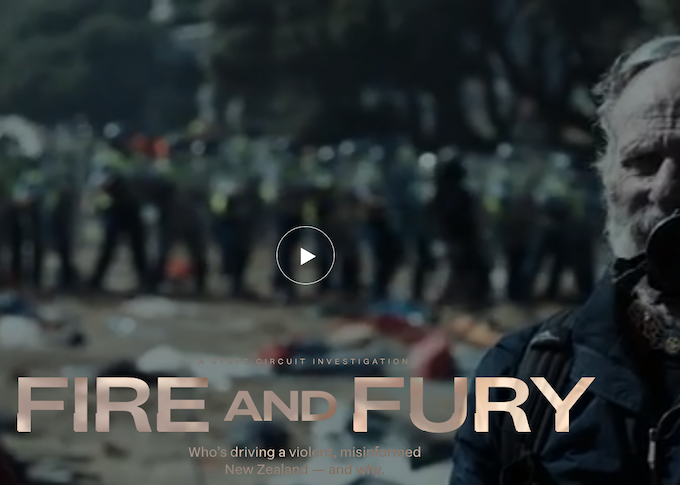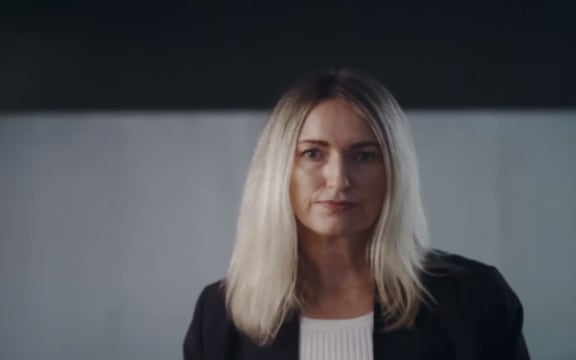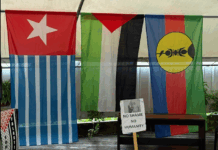
By Hayden Donnell, RNZ Mediawatch producer
A documentary from Stuff Circuit this week delved into Aotearoa New Zealand’s growing extreme far-right and anti-vax movement.
Why did the makers of Fire and Fury decide to platform a group of conspiracy-minded idealogues, and what did it get right that others got wrong?
In February, Newsroom’s Melanie Reid travelled to what was then called “freedom village” to interview some of the people behind the occupation taking place on Parliament grounds, Voices for Freedom leaders Alia Bland, Claire Deeks, and Libby Jonson.
- LISTEN TO RNZ MEDIAWATCH: The conspiracy coverage conundrum
- WATCH Fire and Fury
- Other disinformation reports
“You guys started it yeah? The three of you?” Reid asked. “Three mums.”
“Three mums,” they agreed in unison.
The video feature was part of a wave of press that Voices For Freedom and its allies attracted in recent months.
Altruistic posture
Nurses For Freedom, a group founded by Voices For Freedom local coordinator Deborah Cunliffe, featured recently on Three’s The Project.
“Healthcare clearly matters to New Zealand. Our nurses want to help,” she said.
Cunliffe’s altruistic posture in the interview jarred a little with calls in the Nurses For Freedom Telegram group for Nuremberg 2.0 to be carried out on public figures who backed vaccination and covid-19 health measures.
At the end of that interview, presenter and former Black Cap Mark Richardson pointed out that the healthcare workers in question could get their jobs back with one simple step.
“Get the jab and go back,” he said. “I don’t care what your rationale is.
“Your country needs you. It’s like me fielding under the helmet. I didn’t want to do it but I did it for the good of the country.”
Other coverage was more sympathetic to the anti-vax cause.
Fire and Fury – the documentary. Video: Stuff Circuit
An uncritical eye
A story by Evan Harding in Stuff’s Southland Times cast an uncritical eye over Nurses For Freedom’s claim to represent 700 nurses just waiting to return to work.
But according to figures from the Ministry of Health, only about 500 nurses have been suspended for failing to meet covid-19 vaccine requirements.
Stuff’s article has since been removed, replaced by a message saying it failed to meet the company’s editorial standards, and another article by Harding on vaccinations has received the same treatment.
Stuff wasn’t the only news organisation to pull a story after giving an uncritical platform to an anti-vaxxer.
Last month, The New Zealand Herald carried an article by the Northern Advocate about Brad Flutey, who was protesting against the closure of the Marsden Point refinery.
The story didn’t mention that Flutey is an anti-vaxxer who called for the Parliament protesters to shift their focus to Marsden Point as a way of retaining momentum after their occupation was broken up, nor that he had repeatedly called to overthrow the government, and had faced charges for refusing to comply with covid restrictions and wear a mask while shopping.
After receiving criticism, The Herald took the article down and later replaced it with a rewritten version headlined “Marsden Point Oil Refinery protest passes 100-day milestone in Northland – take two”.
The Platform platforming
While some organisations seem to have elevated these figures either by accident, or in contravention of their own editorial standards, broadcaster Sean Plunket’s platform The Platform has platformed a succession of anti-vaxxers and extremists on purpose.
This week, presenter Michael Laws talked to Counterspin Media host Kelvyn Alp, who once told Act leader David Seymour he was lucky protesters at the Parliament occupation hadn’t strung him up from the nearest lamppost.
An extrajudicial execution would seem like the most extreme possible form of deplatforming, but an association with intolerance does not appear to be a deal-breaker for The Platform, which has the tagline “Open. Tolerant. Free”.
The station had also aired long interviews with leaders of groups like Voices For Freedom and NZ Doctors Speak Out With Science in recent months, some of them not exactly neutral.
The Platform host Rodney Hide put his cards on the table before an interview with Alia Bland, revealing himself to be a member of her group:
“I am a very very very proud member of Voices For Freedom. This is my disclosure. I’m not having someone along that I’m neutral about. I am a fan of Voices For Freedom.”
After his interview with the well-known Facebook anti-vaxxer Chantelle Baker, Plunket was so moved that he even offered her a show.
“Do you want a weekly show on The Platform?” he asked. “I would be happy to have you on board on the strength of the open conversation we’ve had today.”
Personal platform clipped
But today The Herald reported Baker’s personal platform had been somewhat clipped, with her own Facebook page newly deactivated. Though the report said she was operating another page, just not under her own name.
The reason Plunket was making that offer, and interviewing Baker in the first place, was because she had just been featured in a documentary which painted her and other leading anti-vax figures in a less than flattering light.
Fire and Fury by Stuff Circuit came out last Sunday, and features clips taken from conspiracy and anti-vax groups on platforms like Telegram, which show the violent elements of the movement.
“You gotta love that sound of execution. It’s gonna happen,” one clip begins.
“The media in this country need burning. They really seriously need burning,” another voice continues.
The doco also showed a darker side to Voices For Freedom.
Far from just being — in the words of that Newsroom video — the project of “three mums”, Fire and Fury portrays a group which puts up an approachable, folksy front to draw people into a more radical, potentially violent agenda.

‘Fascistic’ ideas lurking
In an interview with host Paula Penfold, The Disinformation Project director Kate Hannah points out potential fascistic ideas lurking beneath some of the group’s messages on vaccines and health.
“The role of women and wellness in fascist and proto-fascist movements has always been really significant. Even in Italy and Germany in the 1920s, a lot of proto-fascist ideas came from or were augmented by ideas around health, well-being, rejection of modern medicine, because obviously if you are an uber-race, you don’t need modern medicine,” she said.
“All of the different groups that we see in New Zealand at the moment have features of fascistic ideas around power and control.”
The documentary also homes in on chat transcripts from former National Front leader Kyle Chapman identifying the “dark-haired” lady from Voices For Freedom as a potential political leader.
Penfold told Mediawatch the Stuff Circuit team decided to do the documentary after watching the Wellington protests and seeing talk on associated social media channels about making the country “ungovernable”.
They wrestled with how to to shine a light on what goes on in the shadier corners of the internet without giving further oxygen to dangerous figures.
“There were many many, many editorial conversations about how we should do that,” she said.
Guided by researchers
Those conversations were guided by groups who had studied the New Zealand far right.
They helped convince the team not to interview some of the people at the centre of their documentary, including Kelvyn Alp, former AUT law lecturer and conspiracist Amy Benjamin, and fellow conspiracy theorist Damien De Ment.
Penfold also cited a 2017 report called The Oxygen of Amplification by US-based independent nonprofit organisation Data & Society.
“We drew most of our guidelines from that on what we should and shouldn’t do,” she told Mediawatch.
That approach was criticised by some journalists, including Plunket, but Penfold said it was necessary.
“They’ve had their say. They have so many hundreds, thousands of hours of material on the internet already, and also the guidelines we were reading said it was dangerous to give them a platform that’s equal to the hate they’re already disseminating. And so this is not your ordinary right of reply situation. In a way it’s like we were giving our audience the right of reply to what’s already been said.”
Different approach
Stuff Circuit took a different approach in an earlier documentary on the conspiracy theorist Billy Te Kahika, where Penfold sat down with him for a long-form interview.
Penfold said the team was also careful then not to platform “dangerous” content.
“We didn’t let him platform any of his conspiracy theory views. That was an important distinction. We were challenging him on things he had said and things he had done and misrepresented in his career,” she said.
“In this instance we just didn’t want to give them an opportunity to revoice the conspiracies they already had voiced. Sitting them down and giving them that right of reply risked re-platforming their dangerous speech and we just didn’t want to do that.”
The question of whether to cover the extreme right, and how to do it, has been a vexed one in the media as conspiracy movements have grown noisier and more influential.
In a recent column for The Herald, Matthew Hooton warned of a “monstrosity” emerging on the right, and concluded with this conundrum for the media:
“Is it best to ignore these extremist movements for fear of giving them a platform? Or is it more important than ever to bring to public attention the true nature of their agenda?” he wrote.
Pacific Journalism Review paper
Disinformation researcher Byron C Clark has looked at that issue in a paper on the media’s coverage of the Parliament occupation for the Pacific Journalism Review.
#PacificJournalismReview #FRONTLINE3: The #NZ #media and the occupation of #Parliament by @byroncclark #altright #antivaxxers #citizensarrest #conspiracytheorists, #Counterspin #disinformation #harassment #mediacoverage #Parliament #qanoncult #Violence https://t.co/vW3VauXZgn pic.twitter.com/mVy6sBjBCR
— David Robie (@DavidRobie) August 21, 2022
Clark said Fire and Fury succeeded where some other attempts to cover the anti-vax extreme right had fallen down.
Though some far-right figures were hoping the publicity they received from the documentary would help grow their movement’s numbers, the documentary’s framing and editorial decision-making should make that unlikely, he said.
“They’re hoping they can use this to bring more people into the fold with their beliefs, but I think that’s going to be difficult to do because it’s put some of the more violent aspects of their beliefs out there and that’s probably for a lot of people going to be the first thing they know about something like Counterspin — that they’re calling for the violent overthrow of the government.”
Clark said the documentary’s approach could help dissuade some vulnerable people from joining conspiracy movements by inoculating them against some of the more pervasive forms of false information being peddled.
He backed Stuff Circuit’s decision not to interview the conspiracist figures they were covering.
“I think rather than giving them more oxygen by covering them in news articles or a documentary like this, it’s providing some of that balance that’s lacking in their own channels.
“It’s really more restoring balance to some of these ideas rather than giving these ideas oxygen.”
This article is republished under a community partnership agreement with RNZ.












































